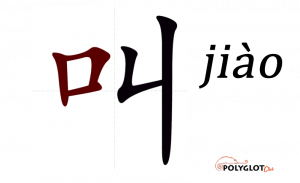Difference between revisions of "Language/Mandarin-chinese/Grammar/叫-(jiào)"
< Language | Mandarin-chinese | Grammar
Jump to navigation
Jump to search
m (Quick edit) |
m (Quick edit) |
||
| Line 1: | Line 1: | ||
<div | <div class="pg_page_title">[[File:叫-(jiào)-polyglot-club-wiki.png|thumb]]How to use the verb <code>叫</code> (jiào)</div> | ||
The verb <code>叫</code> (jiào) means both “to call oneself” and “to be called”. It's a very simple way to give one's name in Chinese. | The verb <code>叫</code> (jiào) means both “to call oneself” and “to be called”. It's a very simple way to give one's name in Chinese. | ||
After mastering this lesson, these related pages might interest you: [[Language/Mandarin-chinese/Grammar/%E6%98%AF...%E7%9A%84|是...的]], [[Language/Mandarin-chinese/Grammar/How-to-ask-a-question-in-Chinese|How to ask a question in Chinese]], [[Language/Mandarin-chinese/Grammar/个-(ge)|个 (ge)]] & [[Language/Mandarin-chinese/Grammar/Negation-Use-不-(bù)-or-没-(mei)|Negation Use 不 (bù) or 没 (mei)]]. | |||
==Structure== | ==Structure== | ||
| Line 24: | Line 24: | ||
<blockquote>This pretty girl is named Ana.</blockquote> | <blockquote>This pretty girl is named Ana.</blockquote> | ||
== | ==Other Lessons== | ||
* [[Language/Mandarin-chinese/Grammar/Conditional-Mood|Conditional Mood]] | * [[Language/Mandarin-chinese/Grammar/Conditional-Mood|Conditional Mood]] | ||
* [[Language/Mandarin-chinese/Grammar/是...的|是...的]] | * [[Language/Mandarin-chinese/Grammar/是...的|是...的]] | ||
| Line 35: | Line 35: | ||
* [[Language/Mandarin-chinese/Grammar/Negation|Negation]] | * [[Language/Mandarin-chinese/Grammar/Negation|Negation]] | ||
* [[Language/Mandarin-chinese/Grammar/Nouns|Nouns]] | * [[Language/Mandarin-chinese/Grammar/Nouns|Nouns]] | ||
<span links></span> | |||
Latest revision as of 23:07, 26 March 2023
The verb 叫 (jiào) means both “to call oneself” and “to be called”. It's a very simple way to give one's name in Chinese.
After mastering this lesson, these related pages might interest you: 是...的, How to ask a question in Chinese, 个 (ge) & Negation Use 不 (bù) or 没 (mei).
Structure[edit | edit source]
Subject + 叫 + Name
This structure can be used with your full name or just your first name.
Examples[edit | edit source]
- 我
叫Tom。/我叫Tom。Wǒ jiào Tom.
My name is Tom.
- 他
叫李小龍。/他叫李小龙。 Tā jiào Lǐ Xiǎolóng.
His name is Li Xiaolong.
- 我 哥哥
叫老木。/我 哥哥叫老木。 Wǒ gēgē jiào Lǎo Mù.
My brother calls himself Lao Mu.
- 這 個 美女
叫Ana。/这 个 美女叫Ana。Zhè gè měinǚ jiào Ana.
This pretty girl is named Ana.
Other Lessons[edit | edit source]
- Conditional Mood
- 是...的
- Express possession with 有 (yǒu)
- Plural
- Be Polite
- Future Tense
- 个 (ge)
- 都 (dōu)
- Negation
- Nouns
